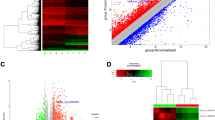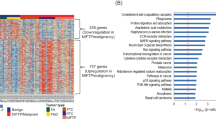Abstract
A gene expression profile analysis using an Affymetrix HG-U133 Plus 2.0 microarray with probes for 38,500 human full-length cDNAs was performed on a primary papillary thyroid carcinoma (PTC) and a nodular goiter (NG). ZCCHC12 was the gene with the most significant differential expression between PTC and NG, and this was verified using fluorescent quantitative PCR (FQ-PCR). A total of 9,485 genes were detected with a difference in transcription levels between PTC and NG. Of these, 2,098 were up-regulated with a signal log ratio (SLR) ≥ 1 and 1,714 were down-regulated with an SLR ≤ −1. Among these up-regulated and down-regulated genes, 12 genes were significantly up-regulated (SLR ≥ 5.0) and 6 genes were significantly down-regulated (SLR ≤ −5.0). The SLR of the ZCCHC12 gene was 8.8. The results of FQ-PCR showed that the medians of the log (ZCCHC12 RNA/GAPDH RNA) in PTC and NG were 0.73 and −1.68, respectively, and the difference between them was significant (P < 0.05). There were no significant correlations between the RNA levels of the ZCCHC12 gene and the clinicopathological and biochemical parameters of PTC in our pilot study. This study showed that a number of differentially expressed genes were discovered between PTC and NG. Significantly, the number of transcript copies of the ZCCHC12 gene in PTC was higher than in NG. The verified results of FQ-PCR were consistent with the microarray screening results. The ZCCHC12 gene may be a novel diagnostic molecular marker of PTC.





Similar content being viewed by others

References
Singer PA, Cooper DS, Daniels GH, et al. Treatment guidelines for patients with thyroid nodules and well-differentiated thyroid cancer. Arch Intern Med. 1996;156:2165–72.
Hegedüs L, Bonnema SJ, Bennedbaek FN. Management of simple nodular goiter: current status and future perspectives. Endocr Rev. 2003;24:102–32.
Tan GH, Gharib H. Thyroid incidentalomas: management approaches to nonpalpable nodules discovered incidentally on thyroid imaging. Ann Intern Med. 1997;126:226–31.
Teng W, Shan Zh, Teng X, et al. Effect of iodine intake on thyroid diseases in China. N Engl J Med. 2006;354:2783–93.
Wong CKM, Wheeler MH. Thyroid nodules: rational management. World J Surg. 2000;24:934–41.
Jemal A, Siegel R, Xu J, et al. Cancer statistics, 2010. CA Cancer J Clin. 2010;60:1–24.
Hamberger B, Gharib H, Melton LJ III, et al. Fine-needle aspiration biopsy of thyroid nodules. Impact on thyroid practice and cost of care. Am J Med. 1982;73:381–4.
Coli A, Bigotti G, Zucchetti F, et al. Galectin-3, a marker of well-differentiated thyroid carcinoma, is expressed in thyroid nodules with cytological atypia. Histopathology. 2002;40:80–7.
Martins L, Matsuo SE, Ebina KN, et al. Galectin-3 messenger ribonucleic acid and protein are expressed in benign thyroid tumors. J Clin Endocrinol Metab. 2002;87:4806–10.
Davies H, Bignell GR, Cox C, et al. Mutations of the BRAF gene in human cancer. Nature. 2002;417:949–54.
Namba H, Nakashima M, Hayashi T, et al. Clinical implication of hot spot BRAF mutation, V599E, in papillary thyroid cancers. J Clin Endocrinol Metab. 2003;88:4393–7.
Kimura ET, Nikiforova MN, Zhu Z, et al. High prevalence of BRAF mutations in thyroid cancer: genetic evidence for constitutive activation of the RET/PTC-RAS-BRAF signaling pathway in papillary thyroid carcinoma. Cancer Res. 2003;63:1454–7.
Cohen Y, Xing M, Mambo E, et al. BRAF mutation in papillary thyroid carcinoma. J Natl Cancer Inst. 2003;95:625–7.
Huang Y, Prasad M, Lemon WJ, et al. Gene expression in papillary thyroid carcinoma reveals highly consistent profiles. Proc Natl Acad Sci USA. 2001;98:15044–9.
Finley DJ, Zhu B, Barden CB, et al. Discrimination of benign and malignant thyroid nodules by molecular profiling. Ann Surg. 2004;240:425–36.
Jarzab B, Wiench M, Fujarewicz K, et al. Gene expression profile of papillary thyroid cancer: sources of variability and diagnostic implications. Cancer Res. 2005;65:1587–97.
DeLellis RA, Lloyd RV, Heitz PU, Eng C, editors. World health organization classification of tumors, pathology and genetics of tumors of endocrine organs. Lyon: IARC Press; 2004.
Cooper DS, Doherty GM, Haugen BR, et al. Revised American Thyroid Association management guidelines for patients with thyroid nodules and differentiated thyroid cancer. American Thyroid Association (ATA) guidelines taskforce on thyroid nodules and differentiated thyroid cancer. Thyroid. 2009;19:1167–214.
Mazzanti C, Zeiger MA, Costouros NG, et al. Using gene expression profiling to differentiate benign versus malignant thyroid tumors. Cancer Res. 2004;64:2898–903.
Aldred MA, Huang Y, Liyanarachchi S, et al. Papillary and follicular thyroid carcinomas show distinctly different microarray expression profiles and can be distinguished by a minimum of five genes. J Clin Oncol. 2004;22:3531–9.
Finley DJ, Arora N, Zhu B, et al. Molecular profiling distinguishes papillary carcinoma from benign thyroid nodules. J Clin Endocrinol Metab. 2004;89:3214–23.
Giordano TJ, Kuick R, Thomas DG, et al. Molecular classification of papillary thyroid carcinoma: distinct BRAF, RAS, and RET/PTC mutation-specific gene expression profiles discovered by DNA microarray analysis. Oncogene. 2005;24:6646–56.
Cho G, Lim Y, Zand D, et al. Sizn1 is a novel protein that functions as a transcriptional coactivator of bone morphogenic protein signaling. Mol Cell Biol. 2008;28:1565–72.
Cho G, Bhat SS, Gao J, et al. Evidence that SIZN1 is a candidate X-linked mental retardation gene. Am J Med Genet A. 2008;146A:2644–50.
Cho G, Lim Y, Golden JA. SUMO interaction motifs in Sizn1 are required for promyelocytic leukemia protein nuclear body localization and for transcriptional activation. J Biol Chem. 2009;284:19592–600.
Li H, Liu Q, Hu X, et al. Human ZCCHC12 activates AP-1 and CREB signaling as a transcriptional co-activator. Acta Biochim Biophys Sin (Shanghai). 2009;41:535–44.
Acknowledgments
This work was supported by the Sun Yat-sen University 985 Program Initiation Fund Phase II, the Natural Science Fund of Guangdong Province (sequence number 07001523, 9451008901002400), and the Medical Research Fund of Guangdong Province.
Author information
Authors and Affiliations
Corresponding author
Rights and permissions
About this article
Cite this article
Li, Ql., Chen, Fj., Lai, R. et al. ZCCHC12, a potential molecular marker of papillary thyroid carcinoma: a preliminary study. Med Oncol 29, 1409–1417 (2012). https://doi.org/10.1007/s12032-011-0018-6
Received:
Accepted:
Published:
Issue Date:
DOI: https://doi.org/10.1007/s12032-011-0018-6



